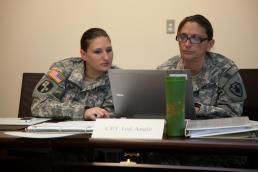Story by: Sgt. Josiah Pugh
Posted: March 28, 2012
 Sgt. Josiah Pugh
Sgt. Josiah Pugh
Agribusiness Development Team Six soldiers work in groups on practice agricultural projects in College Station, Texas. The team is scheduled to deploy to the Ghazni province in Afghanistan this summer to help train Afghans in lost agricultural techniques.
COLLEGE STATION, Texas — Instructors from the Norman Borlaug Institute for International Agriculture of Texas A&M University trained 12 soldiers from the Texas National Guard Agribusiness Development Team Six to better prepare them for their upcoming deployment to the Ghazni province of Afghanistan later this year.
The team is comprised of troops specializing in agricultural fields such as animal, soil, irrigation and crop sciences. During the weeklong training, the Borlaug Institute instructors taught the soldiers how to manage future agricultural projects that will benefit the Afghan people.
“You have an agricultural society that lives off of subsistence agriculture,” said Lt. Col. Jet Hays, commander of the Agribusiness Development Team Six.
Hays explained that at one time, the Afghan people had very complicated irrigation systems that were well engineered and had existed for thousands of years. They also had a very sophisticated way to move agricultural goods around. But with the Russian invasion in 1979, many of the farmers ended up in refugee camps in Pakistan. By the time the war was over, much of the knowledge about advanced agricultural practices was lost.
“Basically you had a generation that forgot their techniques for storing food and farming methods,” said Hays. “We’ll be trying to help them regain some of that knowledge.”
“One of our projects we will be teaching them is how to preserve their food,” said Staff Sgt. Melissa Bright, an agriculture specialist with the team. “They currently sell 90 percent of their production to Pakistan and then rebuy it a couple of months later because they don’t remember how to can their goods.”
With the help of the Borlaug Institute instructors, the team will be able to successfully accomplish their mission of improving the agricultural prosperity of the Ghazni province. But, the benefit of working together extends in both directions.
“They have be so wonderful and they are so diligent,” said Piya Abeygunawardena, Associate Director at the Borlaug Institute. “It has been one of the most pleasant and exciting experiences for me.”
“We have several individuals flown here just to talk with us,” said Bright. “The experience is amazing.”
Agribusiness Development Team Six is scheduled to depart this summer.